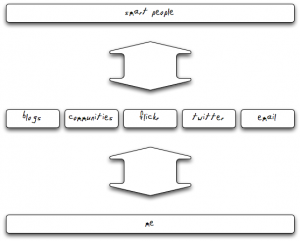 MOOC? Is it a bird? Is it a plane? Is it a bovine farm animal? Nope, it’s a Massive Open Online Course, and it’s what I’ve just plonked myself down into for the next 10 weeks. (Plonked may not be quite the right word — it already looks like it’s going to be more of a frenzied dash. But hey, try and find another verb to rhyme with plenk).
MOOC? Is it a bird? Is it a plane? Is it a bovine farm animal? Nope, it’s a Massive Open Online Course, and it’s what I’ve just plonked myself down into for the next 10 weeks. (Plonked may not be quite the right word — it already looks like it’s going to be more of a frenzied dash. But hey, try and find another verb to rhyme with plenk).
And what’s PLENK? The title of the MOOC, obviously. Do try and keep up. It’s short for Personal Learning Environments, Networks, and Knowledge and here’s a description of the course.
Having developed and worked on the complete antithesis of MOOCs for the past decade, I’m interested to see where the overlaps are with more formal e-learning courses, and how elements of a PLE can permeate and complement small online courses. The PLENK 2010 course already has – gasp – over 1000 people enrolled. And 4 facilitators. All of our online courses have a maximum of 15 or 16 participants – and that’s with 2 facilitators! So you can see why I’m intrigued.
A thousand people enrolled? How does a MOOC work exactly? How can it work? Here’s a video from one of the course facilitators, Dave Cormier, about how to get the most out of a MOOC:
[First question to self: How will I ever find the discipline to follow this?]
However, I can see clear overlaps between PLENK and other (smaller) online courses I have experience of:
- There’s weekly input in the form of a variety of text types (articles, book chapters, blog posts…), video, audio, and images (slideshows, infographs or diagrams etc).
- There are regular synchronous video conferencing sessions – two a week on PLENK in fact (recorded for those who can’t make it)
- There are ongoing asynchronous discussions via a dedicated course wiki, and forums (I see a scary 519 unread messages in one of the course Moodle forums since yesterday. I may be skipping this part of the course.)
- There are asynchronous conversations and artefacts being created by participants via social media such as blogs (like this one), Twitter, Delicious, You Tube… (now that sounds groovy)
It’s this is the last point that most interests me – these conversations and artefacts are created by participants within PLEs, and form an integral part (in fact, the most important part) of the course. What’s a PLE? This is one of my favourite diagrams of a PLE (found in one of the PLENK week 1 readings ):
(I especially love that very small ‘me’ at the bottom).
Through the PLENK2010 MOOC, my PLE, this blog and Twitter, I’d like to explore the following basic questions:
- How can PLEs impact on and mesh with more formal online courses? What are the issues and their solutions? How can online course instructors leverage PLEs for participants?
- What similarities are there between very small, heavily tutor supported (not driven) courses and the hands-off tutoring of MOOCs? (The differences seem fairly obvious)
- What is a participant’s experience of a MOOC (well, my experience)? What sort of learning is perceived – or not?
No doubt these questions will be expanded and refined as the course progresses, but this feels like plenty to start with!
If you’re not one of the thousands already in PLENK2010, you can still join the course. Or you can take one of the lazy options:
- Search for #PLENK2010 in Twitter and follow the conversation and links there.
- Do some of the course reading by searching Delicious. For example, you’ll find links to the reading I especially found useful from this first week of the course in my Delicious account. Use PLENK2010 as the search tag.
- Aggregate course participants’ blogs (like this one), videos and stuff into an RSS feed, using PLENK2010 as the search term.
Looking forward to the learning journey!
Nicky Hockly
The Consultants-E
September 2010


You say plonked, I say plunked, though honestly I don’t think either rhymes with “plenk.”
It’s more a loose resonance, which is fine.
I like the diagram a lot, and would only quibble that the “me” uses pretty much the same size type as the other labels. There’s a certain smartness (or at least self-knowledge) in recognizing that other people are smart, and probably in ways you haven’t gotten to yet.
Hi Dave, and thanks for dropping by. Thanks especially for providing a link to your blog post – it looks like a case of ‘I say tomayto, you say tomahto…’ 🙂 I like that term loose resonance.
Look forward to continuing the PLENK dialogue (or should that be multilogue) on your and other blogs.
“Plonk” has a connotation in Usenet that I’m sure you don’t intend by using it. In Usenet newsreaders one can add other posters to one’s “kill file” (similar to a blacklist in email readers) so their posts don’t show in one’s unread posts list. The usual term for putting a poster into one’s kill file, often with a brief post to the newsgroup with just this, is:
Plonk!
thereby announcing to that poster and the rest of the group that the poster is no longer reading the plonked poster’s contributions. Sounds like a rock dropped in the ocean, never to be seem again…
Hi Wayne, and thanks for dropping by. I’ve never heard of this usage of the verb – thanks for the info! Although I didn’t intend this meaning (as you say), I have to admit that now we are starting week 2 of PLENK2010, I’m feeling rather overloaded with info, and may myself be plummeting like a rock dropped in the ocean never to be seen again 🙂